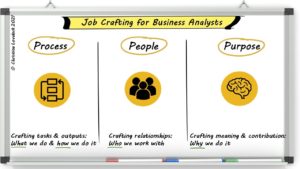Don’t. Step. Back.
‘We need to take a step back’ is a common phrase amongst BAs, and while the intention is understandable, this entreaty simply isn’t helping.
You know the feeling.
- The project is already running away with itself.
- Stakeholders have identified a solution before articulating the problem.
- This great new idea does not align to strategy or objectives.
- The CEO wants to implement a system they’ve seen work elsewhere without understanding our context and challenges.
You know we need to calm down, think logically, act rationally. In every meeting, you want to say things like:
- We need to slow down
- What about the bigger picture?
- Let’s go back a step.
But no one wants to hear that.
The start of initiatives are about energy, motivation and enthusiasm. BAs can be seen as blockers. What we think is pragmatism can be interpreted as negativity.
Restraining Language
When BAs are constantly using language which is perceived as holding back progress, stakeholders begin to avoid us, work around us, and don’t include us in discussions where we could offer a valuable perspective. BAs then become increasingly worried and frustrated, and our warnings become more dire and more persistent.
It can look like our input is focused on restraining the initiative and identifying additional work.
Is it possible deliver the same information in a more impactful way?
Advertisement
Examine Our Role
BAs often feel we are the conscience of a project, and our job is to protect stakeholders and the organization from poor decisions. Is that a reasonable expectation to set for ourselves?
Trying to reign-in a project which has senior backing, forward momentum and is moving at pace is perhaps not the best way to expend our energy. It’s OK to be on board with an idea and to be enthusiastic. We don’t have to ensure every ‘lesson is learned’. It’s more important that the project benefits from an engaged BA that is consulted at the appropriate time and is seen as someone who is contributing to moving the initiative forward.
Enabling Language
Swapping our restraining language for forward-focused language may not be as difficult as we think.
Instead of “We need to take a step back” we can say “We need to be clear on the best next step”.
Instead of using “Yes, but….” to list off all the problems, we can use “Yes, and…” to keep our contribution constructive.
We can use language that says I’m onboard with this project, I want to see it progress and my contribution helps move us forward.
BAs can sometimes see positivity as naivety. It is possible to be positive and well informed. We can use our experience to help projects avoid potential pitfalls, without insisting on a backwards step.
Conclusion
BA don’t need to single-handedly restrain projects. In fact the best way to influence projects and products in the right direction is to demonstrate that we are invested and enthusiastic about the outcome.
Language matters. Swapping restraining language for enabling language shows our stakeholders we care, we understand and want a positive outcome. There may still be difficult messages to deliver, but we can frame these as future-facing hurdles to overcome rather than backwards-facing steps to make.





